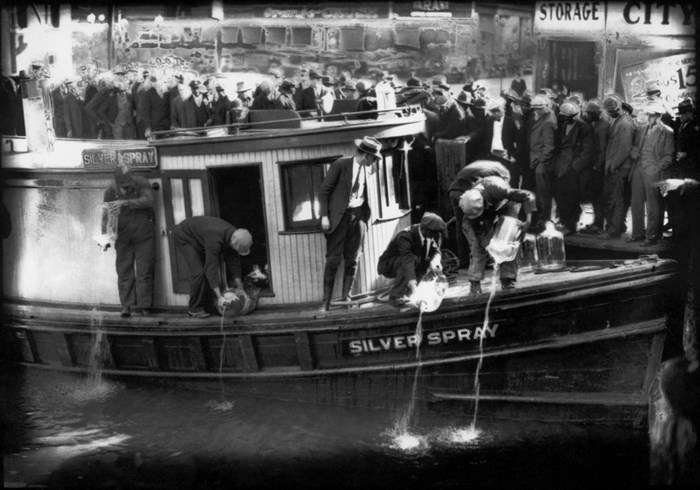
FILE - In this 1922 file photo spectators gather by the side of captured rum runner, Silver Spray, as they watch prohibition agents pour "white lightning" from the five-gallon bottles on the deck into the Elizabeth River, Norfolk, Va. The Prohibition Era, which lasted from Jan. 17, 1920, until December 1933, is now viewed as a failed experiment that glamorized illegal drinking.
Image Credit: (Charles S. Borjes/The Virginian-Pilot via AP)
January 14, 2020 - 8:00 PM
NEW YORK - In this era of bottomless mimosas, craft beers and ever-present happy hours, it’s striking to recall that 100 years ago the United States imposed a nationwide ban on the production and sale of all types of alcohol.
The Prohibition Era, which lasted from Jan. 17, 1920, until December 1933, is now viewed as a failed experiment that glamorized illegal drinking, but there are several intriguing parallels in current times.
Americans are consuming more alcohol per capita now than in the time leading up to Prohibition, when alcohol opponents successfully made the case that excessive drinking was ruining family life. More states are also moving to decriminalize marijuana, with legalization backers frequently citing Prohibition's failures. Many of the same speakeasy locations operating in the 1920s are flourishing in a culture that romanticizes the era.
And in a time of heightened racial divisions, Prohibition offers a poignant history lesson on how the restrictions targeted blacks and recent immigrants more harshly than other communities. That treatment eventually propelled many of those marginalized Americans into the Democratic Party, which engineered Prohibition’s repeal.
”Prohibition had a lot of unintended consequences that backfired on the people who worked so hard to establish the law,” said Harvard history professor Lisa McGirr, whose 2015 book “The War on Alcohol” examines Prohibition’s political and social repercussions.
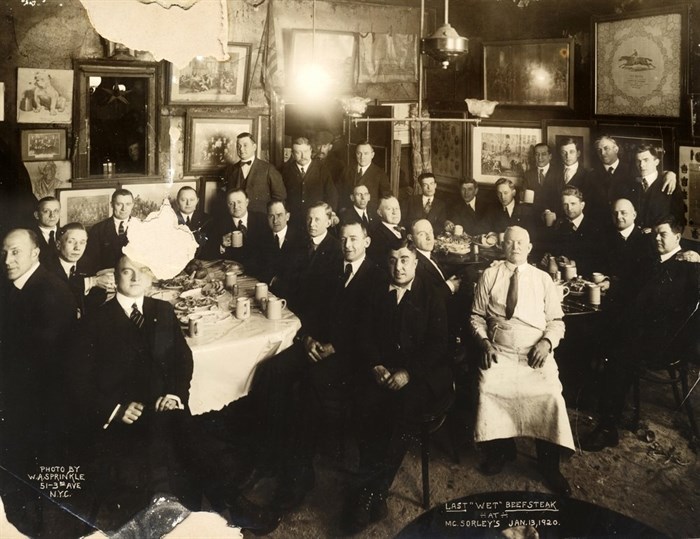
In this Jan. 13, 1920 photo provided by McSorley's Old Ale House, clients and staff pose in the New York bar shortly before the beginning of Prohibition. Located in Manhattan's Lower East Side, McSorley's opened in the mid-19th century, functioned as a speakeasy during Prohibition, and continues in operation today.
Image Credit: (W.A. Sprinkle/McSorley's Old Ale House via AP)
“It helped to activate and enfranchise men and women who had not been part of the political process earlier,” she said. “That was not the intention of Prohibition supporters.”
Ratification of the 18th Amendment in 1919, which set the stage for Prohibition’s launch a year later, culminated a century of advocacy by the temperance movement. Leading forces included the Women’s Christian Temperance Union, the Anti-Saloon League and many Protestant denominations. Prohibition supporters assailed the impact of booze on families and the prominent role that saloons played in immigrant communities.
Prohibition greatly expanded federal law enforcement powers and turned millions of Americans into scofflaws. It provided a new revenue stream for organized crime.
By the time the constitutional amendment was ratified in January 1919, many states had enacted their own prohibition laws. That October, Congress passed a law detailing how the federal government would enforce Prohibition. It was known as the Volstead Act in recognition of its foremost champion, Rep. Andrew Volstead of Minnesota. The law banned the manufacture, sale and transport of any “intoxicating liquor” — beverages with an alcohol content of more than 0.5%, including beer and wine.
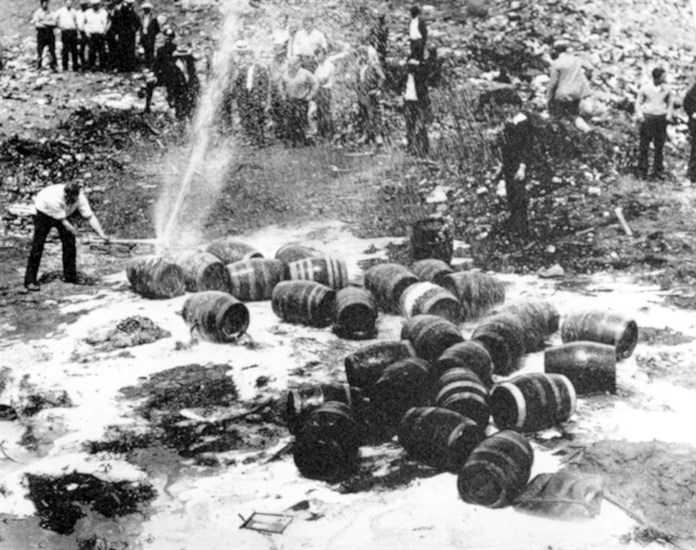
FILE - In this June 18, 1931, file photo beer barrels are destroyed by prohibition agents at a dump in New York City. The federal government, as well as state and local authorities, spent huge sums on enforcement yet never allocated sufficient resources to do the job effectively. Bootleggers awash in cash bribed judges, politicians and law enforcement officers to let their operations continue.
Image Credit: (AP Photo, File)
Statistically, Prohibition was not an utter failure. Deaths from alcohol-related cirrhosis declined, as did arrests for public drunkenness.
What the statistics don’t measure is how extensively Prohibition was flouted. Bootleggers established vast distribution networks. Makers of moonshine and “bathtub gin” proliferated, sometimes producing fatally tainted liquor. Determined drinkers concealed their contraband in hip flasks or hollowed-out canes. Maryland refused to pass a law enforcing the Volstead Act.
McSorley’s Old Ale House, established in New York in 1854 and still flourishing as one of the city's oldest bars, never closed during Prohibition. Ostensibly, it served “near beer” with permissibly low alcohol content, but in fact produced a strong ale from a makeshift brewery erected in the basement.
“It wasn’t a near beer. It was McSorley’s ale,” said the pub’s manager, Gregory de la Haba. “At least once a week, people ask, ‘What did we do during Prohibition?’ And my reply, ‘We made a ton of money.’’’
The federal government, as well as state and local authorities, spent huge sums on enforcement yet never allocated sufficient resources to do the job effectively. Bootleggers awash in cash bribed judges, politicians and law enforcement officers to let their operations continue.

FILE - In this April 28, 1929, file photo a rum runner in Windsor, on the Canadian side of the Detroit River, watches with field glasses for lookout on the American side to signal that no prohibition agents are in sight. His outboard motorboat, loaded with illegal liquor, is shown beneath pilings.
Image Credit: (AP Photo, File)
“Newly hired and poorly trained Prohibition agents, along with local and state police, targeted violators at the margins,” McGirr wrote in a recent article. “But they lacked the capacity, and at times the will, to go after powerful crime kingpins.”
It's simplistic to say Prohibition created organized crime in America, but it fueled a huge expansion as local crime gangs collaborated with those from other regions to establish shipping systems and set prices for bootlegged alcohol. Beneficiaries included Chicago-based gangster Al Capone, who earned tens of millions of dollars annually from bootlegging and speakeasies. In the infamous St. Valentine’s Day Massacre of 1929, gunmen disguised as police officers killed seven men from a gang that sought to compete with Capone’s empire.
Beyond the ranks of gangsters, legions of Americans were committing or abetting crime. Michael Lerner, in his book “Dry Manhattan: Prohibition in New York City," says courtrooms and jails were so overwhelmed that judges began accepting plea bargains, "making it a common practice in American jurisprudence for the first time.”
Anti-immigrant sentiment was a key factor behind Prohibition, partly because of record-high immigration in the preceding decades.
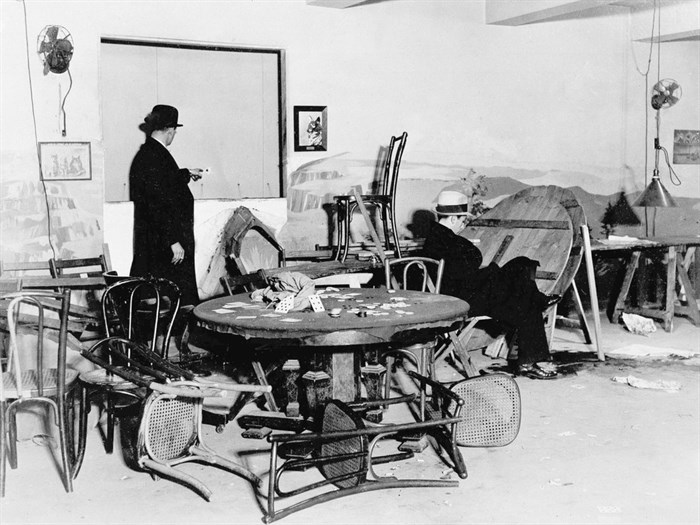
FILE - In this Dec. 31, 1931, file photo the wrecked speakeasy in the Hotel Victoria in mid-Manhattan, where Louis Levine, alias Louis Taylor, a small-time gambler, was killed by one of three gunmen earlier in the day in New York. A bystander points to a bullet hole in the wall, while another is seated in the chair where Levine, known as "Crooked Neck Louie", was gambling when he was shot.
Image Credit: (AP Photo, File)
Saloons in immigrant neighbourhoods were prime targets, says Slippery Rock University history professor Aaron Cowan, because middle-class white Protestants viewed them as political and social danger zones.
“Often the political machines run by the bosses were based in these saloons, or used them as a conduit for extending favours,” Cowan said. “So there was concern about political corruption, changing social values, immigrants learning radical politics.”
Prohibition’s start in 1920 coincided with a major expansion of the Ku Klux Klan, which supported the ban on alcohol as it waged its anti-immigrant, anti-Catholic and racist activities.
The Volstead Act “provided a way for the Klan to legitimize its 100% Americanist mission — it could target the drinking of those they perceived to be their enemies,” McGirr said.
One notorious example occurred in 1923-24 in southern Illinois’ Williamson County, where the Klan mobilized hundreds of volunteers to raid saloons and roadhouses. Hundreds of people were arrested and more than a dozen killed.
That kind of social friction helped spur efforts to repeal Prohibition. Economics also played a role.
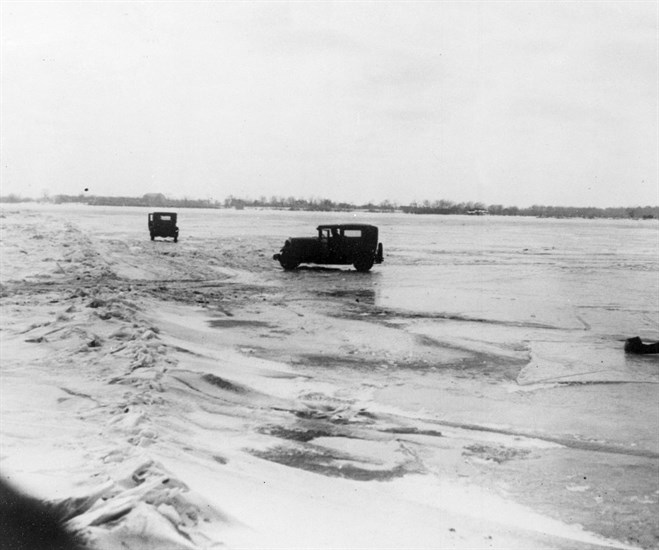
FILE - In this Feb. 14, 1930, file photo large quantities of Canadian beer and whisky are being transported in cars from Amherstburg, Ont., Canada, across the frozen lower Detroit River, to the Michigan side of the international boundary line. The cars are driven with one door open, so if the car goes through the ice the driver can scramble free.
Image Credit: (AP Photo, File)
While some Prohibition supporters predicted it would boost the economy, instead it proved harmful. Thousands of jobs were lost due to closures of distilleries, breweries and saloons. Federal, state and local governments lost billions in revenue as liquor taxes disappeared. One major consequence: Increasing reliance on income taxes to sustain government spending.
The onset of the Great Depression hastened Prohibition's demise, as the need for more jobs and tax revenue became acute. The Democratic Party called for repeal of Prohibition in its 1932 platform; its presidential nominee, Franklin D. Roosevelt, embraced that cause as he rolled to a landslide victory over incumbent Republican Herbert Hoover.
In March 1933, soon after taking office, Roosevelt signed a law legalizing the sale of wine and 3.2% beer. Congress also proposed a 21st Amendment that would repeal the 18th Amendment. Prohibition formally ended that December, when Utah provided the final vote needed to ratify the new amendment.
One of the pithiest summaries of Prohibition came earlier — a scathing assessment from journalist H.L. Mencken in 1925.
Five years of Prohibition "completely disposed of all the favourite arguments of the Prohibitionists,” he wrote. “There is not less crime, but more. There is not less insanity, but more. The cost of government is not smaller, but vastly greater. Respect for law has not increased, but diminished.”
Prohibition’s centennial comes as the United States is incrementally ending the criminalization of marijuana. Recreational use of pot is now legal in 11 states. More than 30 allow its use for medical purposes.
Marijuana remains illegal under federal law, but Ethan Nadelmann, founder of the pro-legalization Drug Policy Alliance, believes most Americans now view the anti-marijuana crusades of America’s “War on Drugs” as misguided in ways that evoke Prohibition.
“Even some of the older generation are saying, ‘We went too far. That was a mistake,’” he said.
News from © The Associated Press, 2020